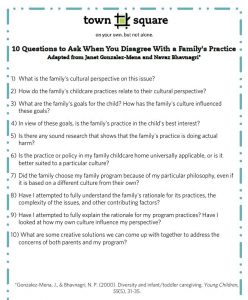When a family makes a commitment to a child care program, they’ve made a statement that they trust the provider to keep their child safe and healthy, and provide an educational and loving environment for that child to grow in. This can be the first step to a strong and long-lasting relationship when educators take the time to intentionally build that with the families of children in their care.
Why is it beneficial to build relationships between educators and families? Often, child care educators are a family’s first experience with having an unrelated adult care for their child. As the introduction to extrafamilial care, child care providers set the tone for the way families engage with all of their child’s education. Setting the stage with warm and caring professional relationships will support families engaging with all of the systems that they will participate in with their child.
A strong relationship between family and child care provider also directly and immediately benefits the child. Family child care educators and families are the people who spend the most time with a child and are in the best position to advocate for them and support their growth and development. When families and educators build strong relationships together, they can communicate more effectively when concerns or disagreements arise. Maintaining relationships with families offers educators the opportunity to better understand every child, and it can give families the comfort necessary to participate in the child’s program and share the interests and skills with the educator and children.
How do family childcare educators seize this opportunity to connect with families and build those professional relationships?
- Start before day one: Although families already have plenty of paperwork to do to enroll, some educators add a “getting to know you” page where families can answer questions that will support the provider in understanding their families history, preferences, and needs. Some sample questions include:
- What language(s) does your child hear and speak at home?
- Who lives in your child’s home(s), including pets? Who do they visit with frequently?
- What do you like to do as a family?
- What does your child typically choose to play with?
- Tell a story: The days can get busy, but proactively making note of something the child said or enjoyed during the day to communicate with families at departure time will maintain that relationship. Prioritizing face to face communication, even for you a minute or two at a time, will make bigger conversations easier when they become necessary. This doesn’t have to happen every day for every child, but the first few days a child is in a program are extra important for making this connection.
- Invite them in: When children are interested in a subject that a parent knows about, or the opportunity for a field trip arises, inviting families in either individually or as a group to share their experience or supervise a trip will build bonds and memories.
For Reflection:
What one action can I add to my day that will help build those reciprocal relationships with families?
Nonviolent communication is “a language of compassion.” While we don’t often think of our words, or anyone else’s, as violent, the emotional harm that we do to others and have done to us is real. Once we can accept that all behavior from children is communication, we are ready to take on a bigger challenge: learning and internalizing that behavior in the form of spoken, written, and body language from adults is communication too.
Because of the close personal nature of our work, it’s almost inevitable that at some point we will have a disagreement with a family member. But these disagreements don’t have to cause long-term damage to relationships. When we are skilled in nonviolent communication, we can strengthen our relationships with families through compassionate and thoughtful conversations, even when the conversations themselves are uncomfortable.
Consider a common source of tension between families and providers: when a child is too ill to attend child care, or becomes ill during the day.
From the provider’s perspective, one ill child will lead to more ill children, and when the care is provided in your home, it can impact your whole family. That might mean your children are sick, or you have to spend even more time cleaning and sanitizing than usual. It makes group care difficult: a sick child won’t want to play, won’t be in a cooperative mood, and may throw off the group routine with heightened need for sleep.
From the family’s perspective, a sick child may mean missing work when they are out of paid leave or in a probationary period. It can be harder to see that a child is ill when they are at home; it’s easier to meet the child’s needs individually rather than in a group setting, and the child is more comfortable at home and may just be happier with their family then they were at child care. Families who are stressed financially might be upset that they are paying for time they can’t use.
Making the call can be anxiety-inducing. Some providers might prefer to avoid the conflict altogether, and not say anything, or passively suggest that the family “keep an eye on” the child for symptoms. Other providers might start on the attack “Why did you send your child here when they’re clearly sick?!” Using non-violent communication urges a different path: First, try to anticipate the other person’s needs. While you can’t make a difference in how the person’s employer will respond to them needing to leave early to pick up a sick child, you can start with empathy. Then state your own need clearly.
“Hi Johanna; I’m sorry to interrupt you at work, I know you just started your new job. I’m calling to let you know that Jamari is running a fever and will need to be picked up before nap time. After he’s been fever-free for 24 hours, we’ll be excited to welcome him back!”
When you begin by acknowledging the other party’s needs, it tells them that you’re aware of what you’re asking. Following by phrasing your own needs clearly and in a positive way (i.e. with a direction, not just “don’t bring him back until he’s better) allows the other person to understand what is expected of them and plan accordingly. Finishing with a personal message also helps to convey that this isn’t a decision you made because you don’t want the child there, but because he’s uncomfortable and you have the responsibility of reducing the risk of contagious illness for all children in your care.
Using the framework of nonviolent communication reduces the room for misunderstandings and for professional boundaries to become personal. You can even use these practices when writing policies– another way to proactively anticipate conflict with families and clarify each party’s responsibilities in the child care setting.
Give families a snap shot of their child’s day in care! Prints two sheets per page.
Sharing ideas on how to use social media – specifically Facebook groups to communicate with families
Adapted from Janet Gonzalez-Mena and Navaz Bhavnagri these questions are helpful for providers to self reflect when struggling with a family’s practice, that is different than their own.


